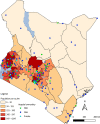Reporting of diagnostic and laboratory tests by general hospitals as an indication of access to diagnostic laboratory services in Kenya
- PMID: 35395040
- PMCID: PMC8992978
- DOI: 10.1371/journal.pone.0266667
Reporting of diagnostic and laboratory tests by general hospitals as an indication of access to diagnostic laboratory services in Kenya
Abstract
Introduction: Information on laboratory test availability and current testing scope among general hospitals in Kenya is not readily available. We sought to explore the reporting trends and test availability within clinical laboratories in Kenya over a 24-months period through analysis of the laboratory data reported in the District Health Information System (DHIS2).
Methods: Monthly hospital laboratory testing data were extracted from the Kenyan DHIS2 between January 2018 and December 2019. We used the national laboratory testing summary tool (MoH 706) to identify the tests of interest among 204 general hospitals in Kenya. A local practitioner panel consisting of individuals with laboratory expertise was used to classify the tests as common and uncommon. We compared the tests on the MoH 706 template with the Essential Diagnostic List (EDL) of the World Health Organisation and further reclassified them into test categories based on the EDL for generalisability of our findings. Evaluation of the number of monthly test types reported in each facility and the largest number of tests ever reported in any of the 24 months were used to assess test availability and testing scope, respectively.
Results: Out of the 204 general hospitals assessed, 179 (179/204) reported at least one of the 80 tests of interest in any of the 24 months. Only 41% (74/179) of the reporting hospitals submitted all their monthly DHIS2 laboratory reports for the entire 24 months. The median testing capacity across the hospitals was 40% with a wide variation in testing scope from one hospital laboratory to another (% IQR: 33.8-51.9). Testing scope was inconsistent within facilities as indicated by often large monthly fluctuations in the total number of recommended and EDL tests reported. Tests of anatomical pathology and cancer were the least reported with 4 counties' hospitals not reporting any cancer or anatomical pathology tests for the entire 24 months.
Conclusion: The current reporting of laboratory testing information in DHIS2 is poor. Monitoring access and utilisation of laboratory testing across the country would require significant improvements in consistency and coverage of routine laboratory test reporting in DHIS2. Nonetheless, the available data suggest unequal and intermittent population access to laboratory testing provided by general hospitals in Kenya.
Conflict of interest statement
The authors have declared that no competing interests exist.
Figures







References
-
- Li L, Georgiou A, Vecellio E, Eigenstetter A, Toouli G, Wilson R, et al.. The effect of laboratory testing on emergency department length of stay: A multihospital longitudinal study applying a cross-classified random-effect modeling approach. Acad Emerg Med. 2015;22(1):38–46. doi: 10.1111/acem.12565 - DOI - PMC - PubMed
Publication types
MeSH terms
Grants and funding
LinkOut - more resources
Full Text Sources

